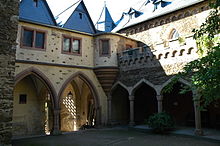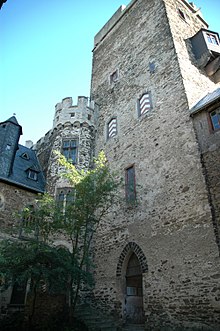Lahneck Castle
| Lahneck Castle | ||
|---|---|---|
|
Lahneck Castle from the Lahnstein |
||
| Creation time : | 1226 | |
| Castle type : | Spurburg | |
| Conservation status: | receive | |
| Standing position : | Clerical | |
| Place: | Lahnstein - Oberlahnstein | |
| Geographical location | 50 ° 18 '22.6 " N , 7 ° 36' 44.9" E | |
| Height: | 164 m above sea level NHN | |
|
|
||
The Lahneck is one in the first half of the 13th century on a steep projecting 164 m above sea level. NHN high rock promontory above the left bank of the Lahn Lahn estuary built Spur castle . It is located in the Oberlahnstein district of the city of Lahnstein on the Rhine and Lahn opposite Stolzenfels Castle . Their floor plan shows a symmetry in the form of an elongated rectangle, which is typical of the castles of the late Staufer period .
history
Since 1226 the Archbishop of Mainz and Elector Siegfried III. von Eppstein Burg Logenecke or Burg Loynecke , as it was called after the Lahn's name at the time, to protect its area at the mouth of the Lahn, where both the Lahnstein and the Tiefenthal silver mine came to Kurmainz through the imperial fief of Frederick II in 1220 . In contrast to many Rhine castles, Lahneck Castle did not serve as a toll castle because it was too far from the Rhine .
The castle chapel was built in 1245. In the same year the castle and also a knight Embricho von Lahneck were mentioned as burgrave for the first time.
In 1298 King Adolf von Nassau was a guest at the castle, shortly before he died in the battle of Göllheim in the fight against King Albrecht I of Austria .
In 1332 Pope John XXII. for participation in the service in the castle chapel consecrated to Ortisei , an indulgence of 40 days. A copy of the indulgence letter can be seen in the chapel, the original is in the Lahnstein city archive.
On July 15, 1338, the Elector of Mainz and Archbishop Heinrich III. von Virneburg from Burg Lahneck participated in the meeting of the electors in Rhens , which then led to the Kurverein zu Rhense .
After 1365 the castle name changed with that of the Lahn from Loynecke in Lahneck.
On August 20, 1400 King Wenzel was declared deposed by the four Rhenish electors meeting at Lahneck Castle - the Archbishops of Mainz , Trier and Cologne and the Count Palatine near the Rhine . As a guest of the Archbishop of Mainz Johann II of Nassau , Friedrich V , Burgrave of Nuremberg, stayed at the castle among many envoys from the cities. On the following day Ruprecht of the Palatinate was on the king's chair in Rhens by the same elector, d. H. so with his own vote, elected German king.
In 1475 at the beginning of his second term of office, Archbishop Diether II von Isenburg placed a second wall ring with a kennel , three shell towers , the fox tower and a square gate tower on the attack side.
Albrecht Dürer's silver pen drawing of two castles, which he made on his journey through the Rhine in 1520/1521 from Holland, does not show Lahneck Castle, but presumably Rheinfels Castle near Sankt Goar and Stolzenfels Castle on the Rhine.
In 1632 and 1636, during the Thirty Years' War , Swedish and imperial troops "tidied up the castle a lot" and the castle then lost its importance. During this time, Wenzel Hollar made a drawing of Lahneck Castle . In 1688, French troops set fire to the last roofs in the War of the Palatinate Succession .
In the course of the secularization of the ecclesiastical principalities operated by Napoleon Bonaparte , Lahneck Castle came to the Duchy of Nassau in 1803 , and in the same year to the bailiff Peter Ernst von Lassaulx.
Since 1852 a neo-Gothic expansion was carried out by the Scottish railway entrepreneur Edward A. Moriarty, director of the Rechts-Rheinische Eisenbahngesellschaft, who acquired the ruins in 1850, and since 1864 by Gustav Göde. A painting of Queen Victoria dates from this period .
In 1878 Count Ewald von Kleist-Wendisch-Tychow acquired the castle for his wife Anna, nee. Freiin von Kleist, who died there in 1892. In 1893 the manufacturer Hauswald from Magdeburg became the owner of the castle. In 1907 the frigate captain and later vice admiral of the imperial navy Robert Mischke acquired the castle, which has since been owned by his family, the Mischke / von Preuschen community of heirs . Until 1937, the further reconstruction took place under the direction of the Karlsruhe architecture professor and doctor Karl Caesar (* December 24, 1874 in Münster , † May 10, 1942 in Berlin ). In 1936–38 the romanticizing crenellated wreaths and flat roofs were removed and partially replaced by pointed roofs
It has been possible to visit the castle at certain times since the 1930s (see events ). The living rooms on the 1st floor are still inhabited at times. The castle complex is an example of the development of a defense structure into a residential castle.
particularities
The castle has a keep (height approx. 29 m) with a pentagonal floor plan similar to Stolzenfels Castle, which is rarely found in castle construction . The pointed side faces south, the weakest side of the castle. It was assumed that stone balls shot from the so-called battle field would slide off the tip rather than cause damage on a flat surface.
The Gothic castle chapel was dedicated to Saint Ulrich. A papal deed from 1332 granted visitors to the chapel a forty-day church penalty ( indulgence ). First mentioned in 1245 as the seat of the Elector Siegfried III. Burgrave Embricho von Logenecke (Lahneck) appointed by Mainz.
Lahneck Castle was the northernmost exclave of the Electorate of Mainz until 1803. Ecclesiastically, Lahneck Castle and the city of Oberlahnstein belonged to the Archdiocese of Trier .


Spiritual greeting
Goethe , Johann Caspar Lavater and Johann Bernhard Basedow stopped in Lahnstein on July 18, 1774 on their boat trip from Ems to Neuwied and had lunch in the local inn on the Lahn . In the face of Lahneck Castle, Goethe dictated the poem Geistesgruß , a preliminary stage to Gretchen's song “ The King in Thule ” in Faust. A tragedy.
The hero's noble spirit stands high on the old tower, Who
, as the ship passes by,
bids it to sail.
See, this herdsman was so strong,
This heart so firm and wild,
The bones full of knight's marrow,
The cup full ;
Half of my life I storm away,
Throw 'half' in peace '
And you, you human ship there,
always drive, always close !
Say
According to one of many legends, the last twelve Knights Templar are said to have defended themselves valiantly against the troops of Archbishop Peter von Aspelt at Lahneck Castle in 1312 .
Idilia Dubb
The 17-year-old tourist Idilia Dubb from Edinburgh allegedly died of thirst in 1851 on the keep of the hilltop castle after the rotten stairs collapsed behind her, and left a diary of the last four days of her life there, which ends on June 19th. Like its skeleton, it is said to have been found years later during the restoration of the tower. Since then, the tower has been climbed again by visitors. It offers a wide view of the Lahn valley and the Rhine valley to Stolzenfels Castle and Koblenz .
trail
The castle is on the excellent hiking trails on the right bank of the Rhine , on the Rheinsteig , on the Rheinhöhenweg , on the Lahnhöhenweg and on the Jakobsweg (Lahn-Camino). Here the hiking trails of the Rheinhöhe cross with the hiking trails of the Lahnhöhe.
Events
- Guided tours of the castle, during which the keep can also be climbed, take place from April 1st to All Saints' Day.
- Candle tours (information on this at the tourist information office of the city of Lahnstein)
- Rhine in flames : large fireworks and ship convoy on the 2nd Saturday in August along Spay , Braubach with the Marksburg , Brey , Rhens , Stolzenfels Castle , Lahnstein with Lahneck Castle and the mouth of the Lahn to the fireworks display from Ehrenbreitstein Fortress in Koblenz .
Monument protection
Lahneck Castle is a protected cultural monument under the Monument Protection Act (DSchG) and entered in the list of monuments of the state of Rhineland-Palatinate . It stands in the district of Oberlahnstein .
Lahneck Castle has been part of the Upper Middle Rhine Valley UNESCO World Heritage Site since 2002 . Furthermore, it is a protected cultural asset according to the Hague Convention and marked with the blue and white trademark.
literature
- Alexander Thon, Stefan Ulrich, Jens Friedhoff : "Decided with strong iron chains and bolts ...". Castles on the Lahn. Schnell & Steiner, Regensburg 2008, ISBN 978-3-7954-2000-0 , pp. 82-87.
- Michael Fuhr: Who wants to be the keeper of the river? 1st edition. Schnell + Steiner, Regensburg 2002, ISBN 3-7954-1460-1 , pp. 76-79.
- Genevieve Hill (Ed.): The Missing Girl. The records of Idilia Dubb. Bertelsmann , 2002.
- Carl von der Osten-Fabeck: Memories of an imperial German naval officer 1866-1906 . Norderstedt 2005; ISBN 978-3-8391-5628-5
- Wilhelm Ruland: The Templars of Lahneck. In: Rheinisches Sagenbuch Cologne 1922, p. 141.
- Wilhelm Schäfer : The strange lady. Ten anecdotes . Insel-Verlag, Leipzig.
- Westerwald-Verein (Hrsg.): Sagen des Westerwaldes. Montabaur 1983, Sage No. 331, p. 221.
- The Rhine from Mainz to Cologne. DuMont art travel guide.
- The Rhine Valley from Bingen and Rüdesheim to Koblenz. Publishing house Philipp von Zabern.
Web links
- Middle Rhine World Heritage Site
- Lahneck Castle
- http://www.lahnsteiner-altertumsverein.de/
- Henriette von Preuschen: Exploring Burg Lahneck ( Memento from October 13, 2005 in the Internet Archive ) (PDF file; 201 kB)
Individual evidence
- ^ Castle history on burgenreich.de
- ↑ Albrecht Dürer: Two castles.
- ^ Entry by Reinhard Friedrich on Lahneck Castle in the " EBIDAT " scientific database of the European Castle Institute, accessed on August 17, 2016.
- ↑ History of Lahneck Castle on its own website
- ^ Carl von der Osten-Fabeck: Memories of an Imperial German Navy Officer 1866-1906. Norderstedt 2005, ISBN 978-3-8391-5628-5 .
- ↑ Lahneck on lahnstein.net ( Memento of 23 January 2005 at the Internet Archive )
- ↑ Lavater's diary of July 18, 1774 in Goethe's Rheinreise, with Lavater and Basedow, in the summer of 1774. Documents, edited by Adolf Bach. Zurich 1923, p. 110
- ↑ The twelve Templars on www.lahneck.de
- ^ General Directorate for Cultural Heritage Rhineland-Palatinate (ed.): Informational directory of cultural monuments - Rhein-Lahn-Kreis. Mainz 2020, p. 53 (PDF; 6.2 MB).








